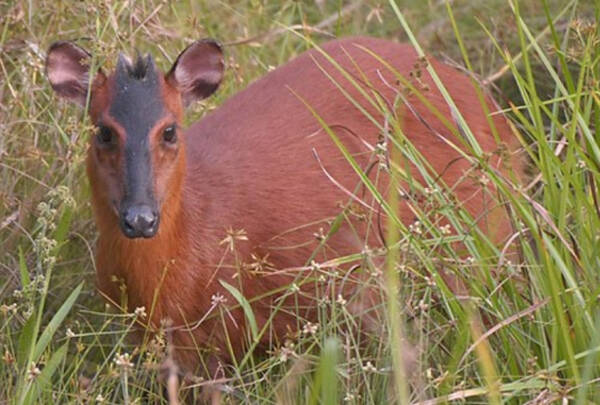Cephalophus nigrifrons
IUCN
LCBasic Information
Scientific classification
- name:Cephalophus nigrifrons
- Scientific Name:Cephalophus nigrifrons
- Outline:Ungulata
- Family:Artiodactylus Bovidae Gazella
Vital signs
- length:85-107cm
- Weight:13-16kg
- lifetime:About 10 years
Feature
There is a tuft of well-developed long hair on the forehead, mainly black or red
Distribution and Habitat
Widely distributed in forests of Lower Guinea and the Congo Basin, from the Niger Delta east to the Albertine Rift, south to northern Angola, and in montane forests of East Africa. The Niger Delta population in Nigeria may differ from the known population in Cameroon (2013). In Uganda, it is found in Bwindi, Impenetrable Forest, Mount Elgon, Rwenzori Mountains, Rwanda Volcanoes and Nyungwe Forest Reserve, and Mount Kenya, and is widespread on Mount Aberdares and Mount Elgon (2013). Isolated populations of the species were recorded in 1986 on Mount Cameroon, Kupe and Manengube.
The black-fronted duiker lives at vertical altitudes from sea level to 4.200 m above sea level. Habitat Tropical forests, usually found in lowland swamp forests and seasonally flooded forests, flooded habitats along streams, and areas with poorly drained or permanently saturated soils. They also inhabit montane forests, subalpine vegetation areas, bamboos, and swamps in Mount Elgon, Mount Kenya, and the Aberda
Appearance
The black-fronted duiker is 85-107 cm long, 55 cm tall at the shoulder, and 15 cm long in the tail; adults weigh 13-16 kg. The fur is a uniform reddish chestnut color all over the body, including the underparts. Species from the mountains of East Africa tend to have coarse fur, particularly long, and are usually darker in color. There is no dorsal stripe, although the nape can sometimes be dark. In some individuals, such as those from the coastal region of Congo (Brazzaville), there may be a small patch of black hair on the shoulders. The legs are relatively long, dark brown or black below the knees and joints. The hooves are elongated. The tail is relatively long, black in color, with a tuft of hair at the tip, and some have scattered white hairs. There is a striking black flame from the nose to the base of the horns, and the rest of the face is the same color as the body. The bright reddish-brown eyebrow stripe on the forehead highlights the edge of this flame. There is a well-develo
Details
Black-fronted Duiker (scientific name: Cephalophus nigrifrons) English: Black-fronted Duiker, French: Céphalophe à front noir, German: Schwarzstirnducker, there are 6 subspecies.

Black-fronted duikers are thought to be territorial, using feces and preorbital gland markings to demarcate territorial boundaries. Densities in Ituri Forest average 1.3-2.0 animals per square kilometer, while in Rwanda's mountain woodland habitats dominated by Hypericum plants, there may be as many as 21.6 animals per square kilometer.
The Black-fronted Duiker often lives in pairs. It is mainly nocturnal, often foraging in open marsh grasslands around dawn and dusk. This species consumes more leaves than other duikers in the area, and has been observed standing on its hind legs to feed on overhanging lichens. It rests in the bush at night, usually on higher (dry) ground, and often uses paths that extend from low-lying feeding areas to popular resting spots. The species is well adapted to marsh habitats, with splayed hooves and long legs; they can be good swimmers, and their preference for flooded habitats may help reduce predation by leopards. If startled, it tends to run in the direction of water. The alarm call is a loud whistle, and a loud noise is often heard when the species runs - the source of which may be the large pouch in the groin (associated with the inguinal gland).
The black-fronted duiker feeds on fruits, seeds, leaves, mosses, lichens, fungi and invertebrates.
The black-fronted duiker is very similar to the Harbour's duiker, with both species having similar red fur, black blazes on the face, and no dorsal stripes. The black-fronted duiker lacks the striking white chin, has a black tail, and has noticeably longer legs.

Little is known about the breeding habits of the black-fronted duiker. In the Central African Republic, scientists have observed pregnant females in December and lactating females in February and March. However, there is not enough data to determine whether the breeding habits of the black-fronted duiker are seasonal.
Based on population density estimates and approximate areas of occurrence, the total population is estimated at 300,000 individuals. However, with increasing human population and bushmeat hunting in equatorial forest areas, the population will continue to decline gradually, and if this trend continues, the species will eventually disappear from most of its current range until it is confined to isolated forest fragments that are effectively protected from hunting and settlement encroachment. The rate of decline is not yet considered to be at a rate consistent with a Near Threatened classification. The preference of the black-fronted duiker for swamp habitats reduces some hunting pressure, although their use of well-traveled trails increases their vulnerability to snaring.
Listed on the IUCN Red List of Threatened Species (IUCN) 2016 ver3.1 - Least Concern (LC).
Protect wild animals and stop eating game.
Maintaining ecological balance is everyone's responsibility!








